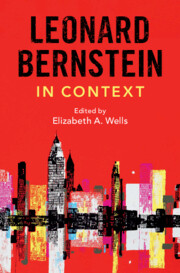Book contents
- Leonard Bernstein in Context
- Composers in Context
- Leonard Bernstein in Context
- Copyright page
- Contents
- Illustrations
- Musical Examples
- Contributors
- Preface
- Part I Bernstein’s World
- Chapter 1 Education
- Chapter 2 Mishkan Tefila
- Chapter 3 Jewishness
- Chapter 4 Sexuality, Relationships, and Family Life
- Chapter 5 Civil Rights Activist and Vietnam War Resister
- Chapter 6 The Cold War, Democracy, and Hope
- Part II Conducting
- Part III Composition, Creation, and Reception
- Part IV Bernstein as Musical and Cultural Ambassador
- Part V Connections
- Part VI The Legacy
- Further Reading
- Index
Chapter 1 - Education
from Part I - Bernstein’s World
Published online by Cambridge University Press: 06 April 2024
- Leonard Bernstein in Context
- Composers in Context
- Leonard Bernstein in Context
- Copyright page
- Contents
- Illustrations
- Musical Examples
- Contributors
- Preface
- Part I Bernstein’s World
- Chapter 1 Education
- Chapter 2 Mishkan Tefila
- Chapter 3 Jewishness
- Chapter 4 Sexuality, Relationships, and Family Life
- Chapter 5 Civil Rights Activist and Vietnam War Resister
- Chapter 6 The Cold War, Democracy, and Hope
- Part II Conducting
- Part III Composition, Creation, and Reception
- Part IV Bernstein as Musical and Cultural Ambassador
- Part V Connections
- Part VI The Legacy
- Further Reading
- Index
Summary
This chapter describes Bernstein’s education, which prepared him well for his chosen activities. His primary and secondary education took place at William Lloyd Garrison School in Roxbury, MA, and his final six years at the demanding Boston Latin School. Bernstein then attended Harvard College, where he earned an A.B. in Music in 1939. His early life also included two hours of daily Hebrew study at the family’s temple from age eight until his Bar Mitzvah. In addition to his largely academic training in music at Harvard, Bernstein studied piano privately from age ten until his college graduation, and then for two years attended the Curtis Institute of Music in Philadelphia, where he studied conducting with Fritz Reiner and piano with Isabelle Vengerova, earning an M.M. His formal study and the many connections that he made while at Harvard and Curtis helped make possible Bernstein’s rapid success as a conductor and composer.
Keywords
- Type
- Chapter
- Information
- Leonard Bernstein in Context , pp. 3 - 10Publisher: Cambridge University PressPrint publication year: 2024

